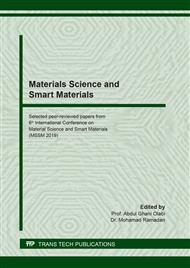p.19
p.25
p.31
p.37
p.43
p.49
p.55
p.61
p.67
Monitoring of Extracellular Matrix Protein Conformations in the Presence of Biomimetic Bone Tissue Regeneration Scaffolds
Abstract:
Tissue scaffolds can be designed to mimic the native extracellular matrix (ECM), making them attractive for the development for a range of regenerative medicine applications. The macromolecules present in the ECM are critical for the provision of structural support to surrounding cells and signalling cues for the modulation of diverse processes including cell migration, proliferation and healing activation. Here, conformational and transitional behaviour of the ubiquitous ECM protein, fibronectin (Fn), in the presence of bone tissue regeneration scaffolds and living C2C12 myoblast cells is reported. Spectral monitoring of Fn functionalised high plasmonic resonance responsive gold-edge-coated triangular silver nanoplates (AuTSNP) is used to distinguish between compact and extended fibronectin conformations. Large spectral red shifts of ~20 to ~59 nm indicate Fn unfolding and fibril formation on incubation with C2C12 cells. The label-free nature, excellent sensitivity and straightforward application of the AuTSNP within cellular environments presents them as a powerful new tool to signature protein conformational activity in living cells and monitor essential protein activity for the assisted development of improved tissue scaffolds promoting enhanced tissue repair.
Info:
Periodical:
Pages:
43-47
Citation:
Online since:
September 2020
Price:
Сopyright:
© 2020 Trans Tech Publications Ltd. All Rights Reserved
Share:
Citation:


